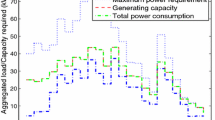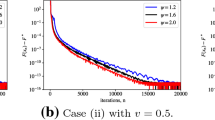Abstract
A new decomposition optimization algorithm, called path-following gradient-based decomposition, is proposed to solve separable convex optimization problems. Unlike path-following Newton methods considered in the literature, this algorithm does not require any smoothness assumption on the objective function. This allows us to handle more general classes of problems arising in many real applications than in the path-following Newton methods. The new algorithm is a combination of three techniques, namely smoothing, Lagrangian decomposition and path-following gradient framework. The algorithm decomposes the original problem into smaller subproblems by using dual decomposition and smoothing via self-concordant barriers, updates the dual variables using a path-following gradient method and allows one to solve the subproblems in parallel. Moreover, compared to augmented Lagrangian approaches, our algorithmic parameters are updated automatically without any tuning strategy. We prove the global convergence of the new algorithm and analyze its convergence rate. Then, we modify the proposed algorithm by applying Nesterov’s accelerating scheme to get a new variant which has a better convergence rate than the first algorithm. Finally, we present preliminary numerical tests that confirm the theoretical development.


Similar content being viewed by others
References
Bertsekas, D., Tsitsiklis, J.N.: Parallel and Distributed Computation: Numerical Methods. Prentice Hall, Englewood Cliffs (1989)
Boyd, S., Parikh, N., Chu, E., Peleato, B., Eckstein, J.: Distributed optimization and statistical learning via the alternating direction method of multipliers. Found. Trends Mach. Learn. 3(1), 1–122 (2011)
Chen, G., Teboulle, M.: A proximal-based decomposition method for convex minimization problems. Math. Program. 64, 81–101 (1994)
Dolan, E., Moré, J.: Benchmarking optimization software with performance profiles. Math. Program. 91, 201–213 (2002)
Duchi, J., Agarwal, A., Wainwright, M.: Dual averaging for distributed optimization: convergence analysis and network scaling. IEEE Trans. Autom. Control 57(3), 592–606 (2012)
Fraikin, C., Nesterov, Y., Dooren, P.V.: Correlation between two projected matrices under isometry constraints. CORE Discussion Paper 2005/80, UCL (2005)
Hamdi, A.: Two-level primal-dual proximal decomposition technique to solve large-scale optimization problems. Appl. Math. Comput. 160, 921–938 (2005)
Hamdi, A., Mishra, S.: Decomposition methods based on augmented Lagrangians: a survey. In: Mishra S.K. (ed.) Topics in Nonconvex Optimization: Theory and Application, pp. 175–203. Springer-Verlag (2011)
Kojima, M., Megiddo, N., Mizuno, S.: Horizontal and vertical decomposition in interior point methods for linear programs. Technical report, Information Sciences, Tokyo Institute of Technology, Tokyo (1993)
Lenoir, A., Mahey, P.: Accelerating convergence of a separable augmented Lagrangian algorithm. Technical report, LIMOS/RR-07-14, 1–34 (2007).
Necoara, I., Suykens, J.: Applications of a smoothing technique to decomposition in convex optimization. IEEE Trans. Autom. Control 53(11), 2674–2679 (2008)
Necoara, I., Suykens, J.: Interior-point lagrangian decomposition method for separable convex optimization. J. Optim. Theory Appl. 143(3), 567–588 (2009)
Nedíc, A., Ozdaglar, A.: Distributed subgradient methods for multi-agent optimization. IEEE Trans. Autom. Control 54, 48–61 (2009)
Nesterov, Y.: Introductory Lectures on Convex Optimization: A Basic Course, Applied Optimization, vol. 87. Kluwer Academic Publishers, Dordrecht (2004)
Nesterov, Y., Nemirovski, A.: Interior-Point Polynomial Algorithms in Convex Programming. Society for Industrial Mathematics, Philadelphia (1994)
Nesterov, Y., Protasov, V.: Optimizing the spectral radius. CORE Discussion Paper pp. 1–16 (2011)
Palomar, D., Chiang, M.: A tutorial on decomposition methods for network utility maximization. IEEE J. Sel. Areas Commun. 24(8), 1439–1451 (2006)
Ruszczyński, A.: On convergence of an augmented lagrangian decomposition method for sparse convex optimization. Math. Oper. Res. 20, 634–656 (1995)
Tran-Dinh, Q., Necoara, I., Savorgnan, C., Diehl, M.: An inexact perturbed path-following method for Lagrangian decomposition in large-scale separable convex optimization. SIAM J. Optim. 23(1), 95–125 (2013)
Tran-Dinh, Q., Savorgnan, C., Diehl, M.: Combining lagrangian decomposition and excessive gap smoothing technique for solving large-scale separable convex optimization problems. Comput. Optim. Appl. 55(1), 75–111 (2012)
Xiao, L., Johansson, M., Boyd, S.: Simultaneous routing and resource allocation via dual decomposition. IEEE Trans. Commun. 52(7), 1136–1144 (2004)
Zhao, G.: A Lagrangian dual method with self-concordant barriers for multistage stochastic convex programming. Math. Progam. 102, 1–24 (2005)
Acknowledgments
We thank the editor and two anonymous reviewers for their comments and suggestions to improve the presentation of the paper. This research was supported by Research Council KUL: PFV/10/002 Optimization in Engineering Center OPTEC, GOA/10/09 MaNet and GOA/10/11 Global real-time optimal control of autonomous robots and mechatronic systems. Flemish Government: IOF/KP/SCORES4CHEM, FWO: PhD/postdoc grants and projects: G.0320.08 (convex MPC), G.0377.09 (Mechatronics MPC); IWT: PhD Grants, projects: SBO LeCoPro; Belgian Federal Science Policy Office: IUAP P7 (DYSCO, Dynamical systems, control and optimization, 2012–2017); EU: FP7-EMBOCON (ICT-248940), FP7-SADCO (MC ITN-264735), ERC ST HIGHWIND (259 166), Eurostars SMART, ACCM; the European Union, Seventh Framework Programme (FP7/2007–2013), EMBOCON, under grant agreement no 248940; CNCS-UEFISCDI (project TE, no. 19/11.08.2010); ANCS (project PN II, no. 80EU/2010); Sectoral Operational Programme Human Resources Development 2007–2013 of the Romanian Ministry of Labor, Family and Social Protection through the Financial Agreements POSDRU/89/1.5/S/62557.
Author information
Authors and Affiliations
Corresponding author
Rights and permissions
About this article
Cite this article
Tran Dinh, Q., Necoara, I. & Diehl, M. Path-following gradient-based decomposition algorithms for separable convex optimization. J Glob Optim 59, 59–80 (2014). https://doi.org/10.1007/s10898-013-0085-7
Received:
Accepted:
Published:
Issue Date:
DOI: https://doi.org/10.1007/s10898-013-0085-7




